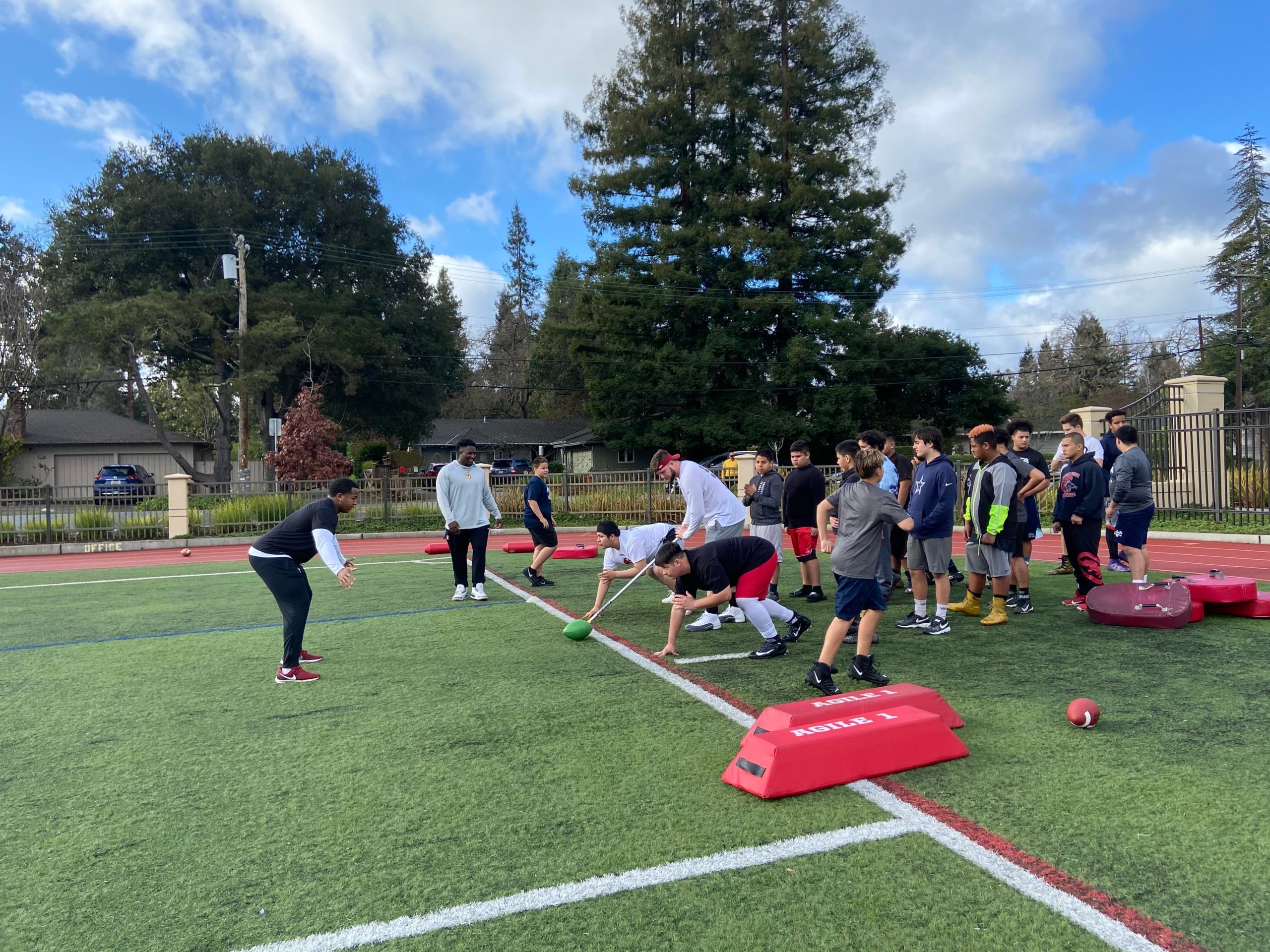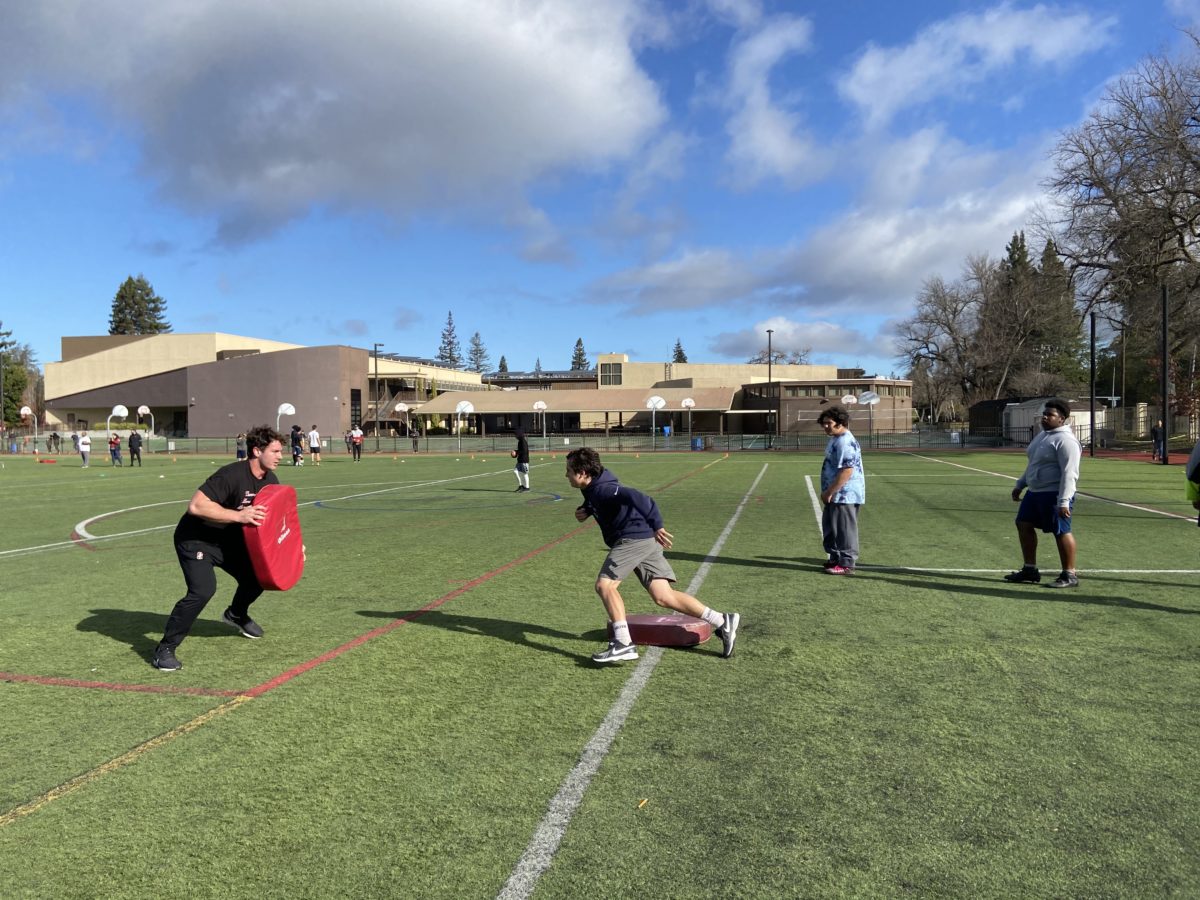With the help of the organization Athletes Guide, nine Stanford football players hosted their first free football clinic on Sunday, Jan. 26 at Hillview Middle School for the community and were paid for their time. For nearly two hours, kids of all ages played football with their heroes under beautiful blue skies and the incessant drum of clean rap music.
Athletes Guide, which connects youth with college athletes to improve their athletic performance, is the first group to receive approval from the first NCAA approved program that lets college athletes earn an income off their athletic ability. The company, which includes former Stanford fullback Daniel Marx ’18 on its core team, made Stanford its first football camp.
“Not only are [the players] giving back to their community, but they’re also getting a chance to make money on their own time,” said Athletes Guide Co-Director of Trainer Operations Cole Dargan. “That’s kind of what was permissible by the NCAA.”
The event was intended to introduce the local community to Athlete Guide services, which also include one-on-one training sessions with athletes. To adhere to the NCAA protocol, the free clinic was advertised as a “Stanford Area,” not “Stanford” event and did not list any names or photos of players until the completion of registration. As such, the job is no different than working at any other non-sport related job; either way, the athlete is not profiting of their likeness. Despite the barrier, the event was filled in 26 hours.
“Stanford is really the first football team we’ve kicked this off with,” Dargan said. “We’ve worked with lacrosse and soccer at a few other schools, but this is the first football team that has really loved the idea and wanted to jump on…[Stanford is] actually player-focused, and they don’t just say that.”
The camp began at 9:30 a.m. at midfield of the soccer turf on Hillview’s campus. After a short pep talk from Marx, the warmup began in earnest. The players put the children through a drill nearly identical to the one seen in Stanford Stadium on Saturdays in the fall.
Sure, the outcome was substantially different — after all, not many 10-year-olds have hands like junior wide receiver Simi Fehoko — but that was not the point. When the kids were tip-toeing down the sideline in the same pre-game drill as Fehoko, as he was there giving them encouragement, they felt like Fehoko.
Of course, the drills were valuable too, but so were the conversations between the players and the kids as they waited in line. The drills were well-designed, and the individualized coaching from Division I athletes lived up to expectations. The one coach who was working outside of his realm of expertise was Connor Wedington, who is a wide receiver at Stanford but was listed as an “Athlete” as a recruit and played running back in high school. As the quarterback coach for the day, Wedington was convinced he had found the next Patrick Mahomes, even as his teammates ragged him.
“Are you really a QB coach?” they joked.
Meanwhile, the receivers worked on a simple slant under the tutelage of senior wide receiver Donald Stewart and Fehoko. In another corner, senior running back Dorian Maddox put the running backs through footwork drills and stressed the central tenet: high and tight.
“Try to make me miss,” Maddox said. “Try to shake me.”
Junior center Drew Dalman taught the fundamentals of pulling as an offensive lineman at his station at the Athletes Guide camp. Dalman was one of eight current players to participate. (PHOTO: Daniel Martinez-Krams/The Stanford Daily)
At the first water break, a few kids lingered around their station, saying, “I don’t need water.”
Senior defensive lineman Michael Williams had none of it.
“You need the water, you need it,” he said.
“Preach,” said the athletic trainer walking by.
Defensive ends junior Dylan Boles, senior Jován Swann and Williams taught the defensive linemen to watch the ball for the cue to explode. The defensive backs, who even at this age have decidedly worse hands than their offensive counterparts, worked on their backpedal and hip rotation. Junior center Drew Dalman drilled the offensive line on pulling to the right and hitting with their right shoulders.
The day ended with a schoolyard style draft to select teams for a relay race. Senior cornerback Treyjohn Butler was one of the captains, and picked first. As he was assembling his team, and the line behind him grew, nervousness began to creep in to his process.
“I was a two-sport athlete [football and track] at my school [Etiwanda High School], so when I hear ‘let’s run faster than everybody,’ I get a little anxious,” Butler said.
“I get excited,” said one of his draftees.
At the end of the race, Butler’s team was well behind, and 10 push-ups alongside all the other non-winning teams was already guaranteed. Even with their fate determined, the runner on the last leg dug deep and made up ground, earning praise in the group huddle to close the day.
After the entire gamut of drills, the whole camp was seated to ask questions of the Stanford football players. Despite some initial trepidation, which caused Butler to ask the first question, the questions came flooding.
“My mom is my role model,” Butler said, ensuring that his voice was heard on the notorious role model question. “When you find your why, you can run through a brick wall.”
Even the questions about football and scholarships were grounded in education. Stewart, who is grad-transferring to Wake Forest for the 2020 season, spoke about overcoming his disappointment that his friends got scholarships before he was offered.
“If you really love football, give your all to football,” he said. “Don’t worry so much about scholarships. Worry about getting good grades.”
Williams even joked about his recruiting process, telling the group seated in front of him that he “didn’t know the difference between Stanford and a Hershey bar” when he started the process.
That huddle ended with one more question, the remarkable type that only kids have the ability to ask, the one that unintentionally stumps everyone. A kid asked, “How is playing in Stanford Stadium different from high school?”
The question prompted numerous laughs from within the Stanford players. “Who wants to take this one?”
Eventually, they settled on a different tactic — to talk about an away stadium — and described the deafening atmosphere inside Oregon’s Autzen Stadium. Player-run from start to finish.
Contact Daniel Martinez-Krams at danielmk ‘at’ stanford.edu.

